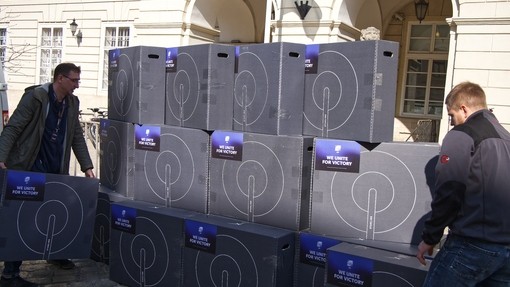
Star(link) Wars: How Elon Musk is providing a tech lifeline to Ukraine
It’s been a typically busy couple of months for Elon Musk.

Not only has the billionaire bought a 9.2% stake in Twitter, joined the board of directors, then decided against joining the board of directors, one of his companies has also actively assisted Ukraine’s defence of its country from the ongoing Russian invasion.
With communications taking a hit in the stricken country, Musk and his SpaceX team has provided crucial equipment to help the country stay online with their Starlink technology. But what is Starlink, and how does it work?
What is Starlink and how does it work?
Starlink is a division of SpaceX, the aerospace manufacturer and space transportation company founded in 2002 by Musk himself. Over the past few years, the business has been launching satellites into orbit as part of its Starlink programme, aimed at supplying high-speed internet remotely across the world. The first launch took place in 2018, and since then regular launches via the Falcon 9 orbital rocket have taken the total number of active Starlink satellites to over 2,100 as of April 2022. Starlink promises to deliver this high-speed internet to locations across the world where service has been either unreliable or unavailable.
The satellites essentially act as signal relayers for internet service. To make Starlink work, customers are required to buy a dish, or ‘terminal’ at a cost of £495. Once this terminal is plugged in, it automatically connects to the nearest satellite. This satellite in turn communicates with the nearest ground station on earth, also known as a gateway. Gateways are located all over the world, but some regions are too remote to access them. The Starlink satellite acts as a bridge between them and the place the internet is required.
The satellites operate in low-earth orbit, which means signal delay is only milliseconds rather than seconds. Speeds of in excess of 200Mbps are realistic to achieve. In order to work efficiently, the terminal needs an unobstructed view of the sky, and there is an app to help users locate suitable positions.
While coverage is possible across most of the global population, the service can only be delivered in countries that have licensed SpaceX to provide it. As of March 2022, the internet service offering is available in 29 countries.
How Starlink is helping the people of Ukraine
With the 2022 invasion of Ukraine by Russia, Starlink is helping the people of the country stay online and connected in the event that the traditional internet communication methods are attacked or destroyed by the Russian advances.
SpaceX had already been in communication with Ukraine regarding the landing rights licence for Starlink several weeks prior to a formal request from government officials, as part of its ongoing plans to expand its reach across Europe. Ukraine’s vice prime minister Mykhailo Fedorov personally reached out to Elon Musk via Twitter for assistance, and two days later a batch of new terminals arrived in the country. Upon tweet confirmation from Fedorov, SpaceX essentially received landing rights permission and the service could be activated.
The number of terminals has since expended. According to Space.com:
“The majority of the terminals — 3,667, to be exact — as well as the associated internet service were donated directly by SpaceX at a cost of “roughly $10 million,” with the United States Agency for International Development (USAID) purchasing the remaining 1,333 terminals. These numbers apparently came from an earlier version of the USAID release; the updated release doesn’t give dollar figures and refers only to 5,000 Starlink terminals donated by a public-private partnership.”
Is the use of Starlink dangerous to the people of Ukraine?
Cybersecurity experts have warned that the Starlink technology could prove to be more dangerous to the people of Ukraine than many might think. Given that the terminals must have an uninterrupted view of the sky in order to work, concerns have been raised that this exposes them to visual detection. Musk himself tweeted that users should ‘lightly camouflage’ the dishes, but experts point out that it’s critical that the views are uninterrupted, making camouflage almost impossible.
Furthermore, as with any form of wireless communication technology, the signals emitted can be tracked, as Jason Healey, senior research scholar at Columbia University’s School of International and Public Affairs (SIPA) comments:
“Any modern military can typically either triangulate those signals to target them with artillery or airstrikes or use a missile which hones in directly on such signals. If Russia cared and had a suitable electronic warfare plane in the air, they should be able to easily locate and identify the transmitter. The plane is able to literally point out where on the ground the Starlink dish lies.”
Whatever happens in Ukraine, it’s clear to see that Starlink will feature heavily in the future of global connectivity. The technology has the potential to bring high speed internet to places in the world that it has otherwise eluded, providing a communications lifeline to millions.
Are we becoming too reliant on tech? Read our blog here to find out what happened when a huge portion of the internet went down.
Search our latest jobs in tech here
















